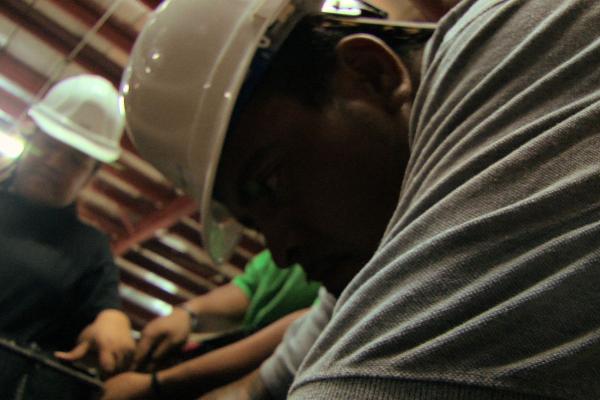New Opportunities
With the support of the NEG program, Chef Sualua helps Samoans eat healthier, build their culinary skills, and find new jobs – or make their own.
Laautuvanu Sualua Tupolo has prepared food in some of the finest hotels and dining rooms in the world – on three continents – and served as Executive Sous Chef and Culinary Instructor at Weimar Center of Health and Education in Weimar, California. Now he is sharing his wisdom with aspiring food services professionals, health educators, and even moms back at home in American Samoa.
Like so many other Samoans who built successful careers on the US mainland or elsewhere, Chef Sualua returned to the island intent on “giving back.” It did not take him long to figure out what his contribution would be.
“Samoans are natural cooks – food is central to religious and cultural celebrations on the island. But most rely on knowledge passed down from generation to generation and lack an understanding of the science underlying food preparation – as well as nutrition and food safety.” The absence of these skills among Samoans was impeding the development of globally competitive food enterprises and undermining healthy eating habits in homes and schools in the territory
And no training program or other food-related professional development opportunities existed in American Samoa. Chef Sualua began developing networks, offering public education on ethnic and health-conscious cooking and eating, and incubating ideas for diversifying menus and raising the standards for food preparation and service in American Samoa.
In 2010, Chef Sualua partnered with the American Samoa National Emergency Grant (NEG) program to launch the the American Samoa Culinary Academy.
A New School & A New Career
A hub of activity even before sunrise, the Academy opens its doors for classes at 7:30am. White uniformed students stream in each day for four months. The introductory level program provides training in four areas: cold food, hot food, baking and garde manger (cold storage just before serving). Chef Sualua insists on mastery of not just food preparation but culinary math, computer literacy, and job-readiness. His students study food science, prepare and cook food, and plate and serve meals, but they also develop resumes and practice their interviewing techniques so they can find jobs once their training is complete.
Students come with varying levels of experience – some have worked in food service, others have not; some have completed formal schooling, others not; and for some, the Culinary Academy is the first step to a first job, while for others, it’s the chance to fulfill long-held career aspirations.
For Fa’afoi Fono, it was a life-changing opportunity.
Fa’afoi worked for Chicken of the Sea for 15 years. September 29, 2009, the day the tsunami struck, was her last day.
When she found the NEG program, she was just trying to find a job. But when the NEG staff told her about the Culinary Academy, it prompted her, for the first time, to consider building a career. She enrolled in the program, quickly becoming a top performer. When we met Fa’afoi, she had recently declined a job offer, opting instead to complete her apprenticeship with Chef Sualua in the student-run cafe adjacent to the Academy.
“I wasn’t ready to stop learning,” she explained. “I want to learn all I can from Chef before I go.”
A Business with a Social Mission
The Academy is a social enterprise. It’s one of few vocational training programs in American Samoa, and the only culinary school. It is in the process of attaining American Culinary Federation accreditation and building intermediate and advanced curricula in service of an eventual accredited degree program. It operates a catering business and student-run cafe that subsidize the training program, and has developed relationships with top-tier restaurants on the island and with high-volume enterprises such as the school lunch program.
Although questions about its long term viability remain, the Academy is betting that it can catalyze a virtuous cycle in which its skilled food service graduates raise the expectations (and the wages) associated with food-related occupations – or start more competitive businesses themselves – generating an increased demand for training.
The venture has created keen interest and enthusiastic support among neighboring businesses, even as cultivating relationships with smaller restaurants and food businesses has been a challenge. Quite recently, the Academy established a formal partnership with Native Hawaiian Holding Company (NHHC), which provided needed access to growth capital and technical support for the enterprise. The purchase of two restaurants that could employ Academy graduates is also in the works (for more information, see the Postscript addendum to this report).
Online, supporters clearly outnumber detractors, with “Future Chef in the Making” commenting on one website “All that’s left to know now is...HOW TO APPLY!!!!”
At the writing of this report, 98 participants had enrolled in training and 95 have completed it. Fifty-two had found jobs.
Fa’afoi Fono is one of them.

